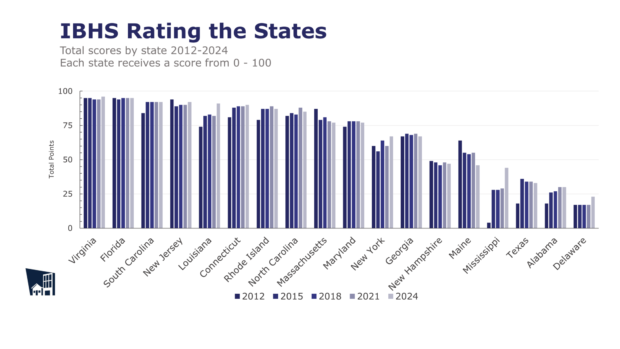In a newly released ranking of hurricane-prone states, Virginia pushed Florida out of the lead to top the list in building code adoption and enforcement.
The fifth edition of “Rating the States,” released today by the Insurance Institute for Business & Home Safety (IBHS) evaluates building code adoption, enforcement and contractor licensing in 18 states along the hurricane coastline from Texas to Maine.
The report found that “many communities remain vulnerable because state or local jurisdictions have failed to adopt or enforce modern building codes or have allowed their codes to lapse and become outdated.”
“Most people trust their state, city, or town has rules or codes to ensure homes are built to be safe and strong,” explained IBHS CEO Roy Wright. “Yet, despite their proven effectiveness, less than 35 percent of Americans live in communities with an adopted modern building code.”
To coincide with building code cycles IBHS conducts the report every three years.
Each state is ranked on a 100-point scale through analysis of specific factors in the current code environment that influence windstorm resilience.
The report details best practices in residential-related building regulations and provides a roadmap each state can follow to improve its ability to mitigate damage from severe windstorms.
After two consecutive second-place finishes, Virginia topped the 2024 Rating the States list with a record-setting score of 96.
The state climbed back to the top spot after adopting the 2021 International Residential Code (IRC) and improving training programs for code officials and contractors, IBHS said.
Florida, a top spot holder since 2018 matched its 2021 score of 95, but slipped behind Virginia in this year’s ratings.
“While not the top-rated state this time, Florida has a lot to be proud of,” said IBHS Managing Director of Standards and Data Analytics Dr. Ian Giammanco. “After Hurricane Ian hit the state in 2022, IBHS assessed the performance of more than 3,000 homes. We estimate the protections included in the modern Florida Building Code prevented between $1 and 3 billion in damage to single-family homes, alone.”
South Carolina, identified as the “state to watch” in the 2021 report, ranked third this year with New Jersey coming in fourth.
Louisiana jumped three spots to fifth place after making training mandatory for code officials and adopting the 2021 IRC, the IBHS report noted.
The state also showed its commitment to resilient construction and re-roofing when it launched the Fortify Louisiana Homes program providing grants to homeowners to upgrade roofs to the voluntary, beyond-code FORTIFIED standard.
Connecticut rounds out the top third of the list with a score of 90.
“It is encouraging to see a record six states score in the 90s on this report,” said Giammanco. “Yet, eight of 18 states have lower scores than they did in 2021. By not advancing efforts to increase resilience, these states risk falling behind and leaving their citizens and communities vulnerable to storms.”
North Carolina lags six years behind the latest code, the report noted; a moratorium on code adoption passed last year means it will not update its code until at least 2031.
“The Tar Heel State lost three points in this year’s Rating the States study and remained eighth in the rankings but will likely fall in future reports as other states adopt newer versions of the code over the next seven years,” the report noted.
Rhode Island, Massachusetts and Maryland – eighth, ninth and 10th respectively – each lost one point since the last report in 2021. New York was the only state in the middle third to gain points, and its seven-point increase led it to tie with Georgia at 11th place.
Mississippi improved the most since 2021, gaining 15 points by requiring licensing, competency testing and continuing education for contractors, the report found.
Unfortunately, the requirements do not apply to roofers and the state is still in the bottom third of the ratings.
Delaware gained six points since the 2021 report but remains at the bottom of the rankings with just 23 points.
The rest of the bottom-third includes New Hampshire (13th), Maine (14th), Texas (16th) and Alabama (17th).
According to the report, since 2008, no state in the report has adopted a new residential code and enacted uniform statewide enforcement of that code.
“In the absence of statewide codes, local jurisdictions must fill the gap,” IBHS noted.
This can lead to greater inconsistencies in construction and leaves some communities far more vulnerable to extreme weather than others, the report stated.
Giammanco notes that inconsistent code adoption and enforcement resulted in catastrophic losses when Florida was impacted by Hurricane Andrew, which ultimately led to the state’s focus on a strong code environment.
“The states in the lower third of the rankings have less than half the points of Virginia, with Delaware sitting an astounding 73 points behind,” added Wright. “In these states, the onus for protecting homes is squarely on homeowners, who must look to voluntary construction standards, like FORTIFIED, to ensure they’re ready for a storm.”
The full 2024 Rating the States report is available at www.ibhs.org/public-policy/rating-the-states.





















 Insurance Costs, Climate Concerns Factor Heavily in U.S. Home Buying Decisions
Insurance Costs, Climate Concerns Factor Heavily in U.S. Home Buying Decisions  U.S., UK, and Canada Consumers Suffer the Most Data Breaches: Report
U.S., UK, and Canada Consumers Suffer the Most Data Breaches: Report  Is the AI Boom a Bubble Waiting to Pop? Here’s What History Says
Is the AI Boom a Bubble Waiting to Pop? Here’s What History Says  U.S. High Court Rejects $2.46B Boy Scouts Sex Abuse Settlement Challenge
U.S. High Court Rejects $2.46B Boy Scouts Sex Abuse Settlement Challenge 



